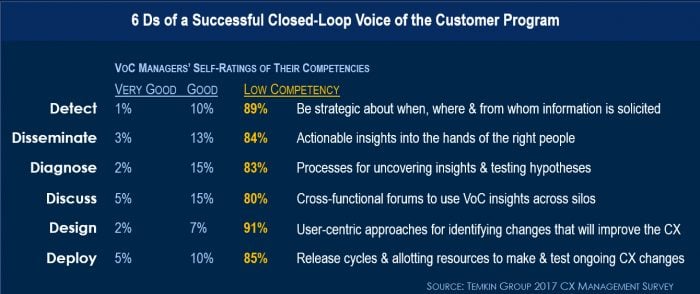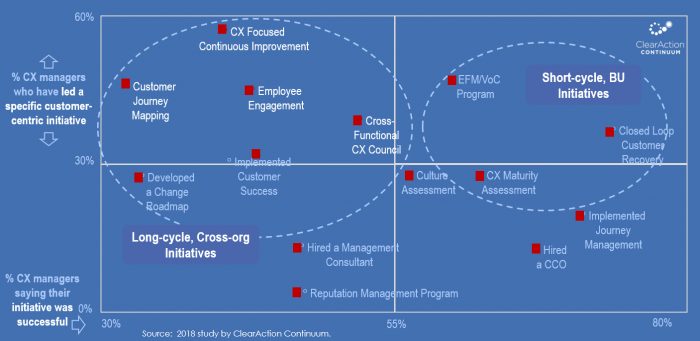 Customer experience annuities are a compelling source of growth that is commonly overlooked. As a gift that keeps on giving, customer experience annuities free-up resources that were previously dedicated forever to the equivalent of “Band-Aids®”, and re-allocate those resources to higher-value opportunities.
Customer experience annuities are a compelling source of growth that is commonly overlooked. As a gift that keeps on giving, customer experience annuities free-up resources that were previously dedicated forever to the equivalent of “Band-Aids®”, and re-allocate those resources to higher-value opportunities.
For example, a large percentage of customer escalations, customer service/success, and customer loyalty/churn investments address things that would not have occurred if they were done right the first time and consistently from customers’ perspective. Strategic actioning of these issues’ root causes can significantly reduce value-rescuing resources in favor of value-creating resource expansion.
Customer Experience Improvement Actions
There are 3 levels of customer experience improvement: (1) resolving the instance, (2) preventing recurrence, and (3) preventing occurrence of issues that bother customers.
What bothers them bothers your company’s quest for growth:
- Customers’ negative word-of-mouth dilutes the value of your brand equity, marketing, PR and positive word-of-mouth.
- Customer requests for resolution expands your costs in technologies and personnel (including opportunity cost: productivity trade-off in problem-solving vs. value-creating) for customer service, customer success, warranties or returned material authorizations (RMA), and escalations.
- Customer cycle time delays for payments and purchase decisions reduces productivity of your accounts receivable and sales teams, among others.
- Customers’ share of budget reductions and churn require costly incentives, loyalty programs, and customer success investments to maintain market share.
Accordingly, mature customer experience management can reduce business risk. As described throughout this series on CEO’s Guide to Growth through Customer-Centered Management, customer experience is customers’ realities compared to their expectations. Customer experience management, as it should be managed, is alignment of the company to customers.
1. Resolving the instance is the norm today, driven by voice-of-the-customer technology vendors’ emphasis on closing the loop with customers who rated something poorly in a survey. While useful, the effort and bandwidth dedicated to one-by-one fixes should be balanced with impact on the subset of a subset of customers (survey participants are a small percentage of the customer base, and poor raters are a smaller percentage still).
In ClearAction’s 5-year study of global B2B customer experience practices we found that the rigor of resolving the instance was overwhelming managers from addressing pervasive issues reported period after period in survey results. The pervasive issues reduce response rates, customer engagement, and lifetime value as they erode trust: “why do the same issues recur after I told you about them?”
2. Preventing recurrence of perpetual issues experienced by customers is the heart of customer experience management. This is the source of customer experience annuities.
After a merger added 20,000 small and medium business accounts to tw telecom’s customer base, the Operations SVP instilled a hunger for VoC across the company. Through cross-functional collaboration, they reduced customer churn by 27%, increased Net Promoter ScoreTM by 65%, and outperformed competitors by 20% in sales, purchasing, ordering, installation, billing, service inquiry, maintenance and account management processes.
Establishing systematic habits in an enterprise to prevent recurrence of customer issues is known as “operationalizing customer experience“. Among Net Promoter Score® fans, it’s called “closing the outer loop” whereas resolving the instance is known as “closing the inner loop”.
Preventing recurrence is rarely practiced because (a) executives expect quick wins in revenue up-tick, (b) tech vendors emphasize real-time dashboards and resolving the instance, and (c) pervasive issues span multiple organizations.
As shown in Temkin Group’s research findings below, the cross-organizational collaboration required to prevent recurrence is particularly problematic as most customer experience managers have weak skills in speaking the language of various managerial disciplines, stakeholder analysis, quality tools such as Pareto analysis, root cause analysis, process mapping and Gantt charts, and formal change management.

These weaknesses are further evidenced in ClearAction’s research findings of low success rates among long-cycle, cross-organizational customer experience initiatives:
When it’s systematic it drives growth. A 288% increase in customer lifetime value was achieved by immersing Adobe employees at all levels in customers’ realities, emphasizing the end-to-end customer life cycle, and reviewing action plans regularly with senior leadership for resolving customers’ top issues. $22 million annually in cost to serve customers was saved by reducing time to resolve issues by 89% for more than 130,000 customers. That’s in addition to the revenue gains represented by ongoing higher lifetime value of many segments of customers besides their key accounts.
Reducing negative word-of-mouth by 1% results in 300% revenue growth over increasing positive word-of-mouth by 1%, according to the London School of Economics’ Advocacy Drives Growth study.
 3. Preventing occurrence of customer issues is known as “embedding customer-centricity DNA” throughout your company’s culture. Thorough understanding of customers’ expectations and realities is a prerequisite to preventing issues that bother customers. This understanding must permeate all disciplines’ decision-making and handoffs across your enterprise.
3. Preventing occurrence of customer issues is known as “embedding customer-centricity DNA” throughout your company’s culture. Thorough understanding of customers’ expectations and realities is a prerequisite to preventing issues that bother customers. This understanding must permeate all disciplines’ decision-making and handoffs across your enterprise.
The rarity of this practice is shown in Temkin’s research that less than 10% of companies are operationalizing or aligning their organization to customer experience insights, and less than 5% are embedding customer-centricity as a way of life.
When I led customer experience management at Applied Materials, we pursued embedding customer experience insights into every course in our internal Applied Global University. We made customer experience improvement part of everyone’s job performance criteria. All supervisors-and-above received a monthly presentation slide with talking points to discuss customer experience expectations, realities, and techniques in their staff meetings. All vice presidents visited with 3 counterparts in customer companies on a regular basis in Executive Listening Sessions. All General Managers’ bonuses had a significant component based on preventing recurrence of customer issues. By doing this, we avoided a potential crisis with our largest customer and saved millions of dollars and thousands of hours for our whole customer base and for ourselves. We embarked on the path to making customer-centricity a way of life.
Customer Experience Innovation Actions
While customer experience annuities are generated through preventing issue recurrence and occurrence, sustainable revenue growth is stimulated by customer experience innovation.
An 8X revenue advantage from customer-inspired innovations versus internally-inspired innovations was discovered in an MIT study reviewing revenue growth from 1,193 successful innovations across 9 industries over a 5-year period.
Innovations in customer experience are novel approaches, anywhere along the end-to-end customer journey, that provide mutual value to customers and your company. Shared value can be time-saving, cost-saving, revenue-generating, capability-building, risk-reducing, stress-saving, convenience-building, etc.
Customer experience innovations can occur in the solution itself, policies, processes, affinities, business models, convenience or culture — all of these affect customers’ experience.
Everyone in your company can be creative. “There’s this common perception among managers that some people are creative, and most aren’t. That’s just not true,” says Teresa Amabile, who was head of Entrepreneurial Management at Harvard Business School. “As a leader, you don’t want to ghettoize creativity; you want everyone in your organization producing novel and useful ideas, including your financial people. The fact is, almost all of the research in this field shows that anyone with normal intelligence is capable of doing some degree of creative work.”
Many companies put this in-play. Procter & Gamble’s CEO, A.G. Laffey, encouraged his 100,000+ employees to tap into their creativity: “At least 85% of the people in our organization thought they weren’t working on innovation. They were somewhere else: in line management, marketing, operations, sales, or administration. We had to redefine our social system to get everybody into the innovation game. Today, all P&G employees are expected to understand the role they play in innovation.”
AT&T engaged managers in a range of disciplines in applying human-centered design to processes as well as services. Employees in any discipline at Adobe have long been encouraged to submit innovative ideas to peer review boards who can incubate the ideas through agile design, iterative customer feedback, and bringing the ideas to market. A sort of “undercover boss” method of immersing employees into customers’ realities builds empathy and contributes to prevention of issue recurrence, prevention of issue occurrence, and mutual value innovation.
Customer-Centered Growth
A prerequisite to both improvement and innovation at the levels described above is collection and interpretation of voice-of-the-customer in ways that inform all disciplines. The best way to start this is to harvest customer-initiated inputs, which typically reveal: “I was trying to do X, then Y happened (or failed), so my consequence is Z.” This customer intelligence is much richer than typical company-initiated voice-of-customer. You’ll find something for everyone and every process revealed in this guidance.
To differentiate customer experience, set your sights higher than industry norms. Don’t hop on the bandwagon of customer experience myths, short-sighted and short-lived gains, or lopsided value. Use the advice from this article series to up-level performance to right the first time and consistently from customers’ perspective.
Shift from value-rescuing resource dedication to all-hands value-creating as a way of life. The key is to weave-in customer insights to each discipline’s rhythms, routines and charter. Show them how customers make their salaries, budgets and dividends possible. Intertwine right the first time as seen by customers with their daily decisions and handoffs. Align from the top, bring all hands on-deck, and systematize customer experience improvement and innovation in a way that transcends silos.
Growth through customer experience management can be accelerated, heightened and sustained when it is pursued cross-organizationally with strong synchronization to customer insights and with the aim to align your company to customers. It will reduce business risk, minimize costly incentives, increase productivity, shrink costs, and strengthen the value of your marketing, PR, positive word-of-mouth and brand equity.
This article is fifth of a six-part series as an exclusive CustomerThink Advisors column: CEO’s Guide to Growth through Customer-Centered Management. This series explores ClearAction Continuum’s Customer Excellence DNATM methodology as introduced in the article What is Customer-Centricity DNA?
Other articles in this series:
1. CEO’s Guide to Growth through Customer-Centered Management
2. CEO’s Guide to Growth through Customer Experience Alignment
3. CEO’s Guide to Growth through Customer Experience Engagement
4. CEO’s Guide to Growth through Customer Experience Momentum
5. CEO’s Guide to Growth through Customer Experience Action
Image licensed to ClearAction Continuum by Shutterstock.





